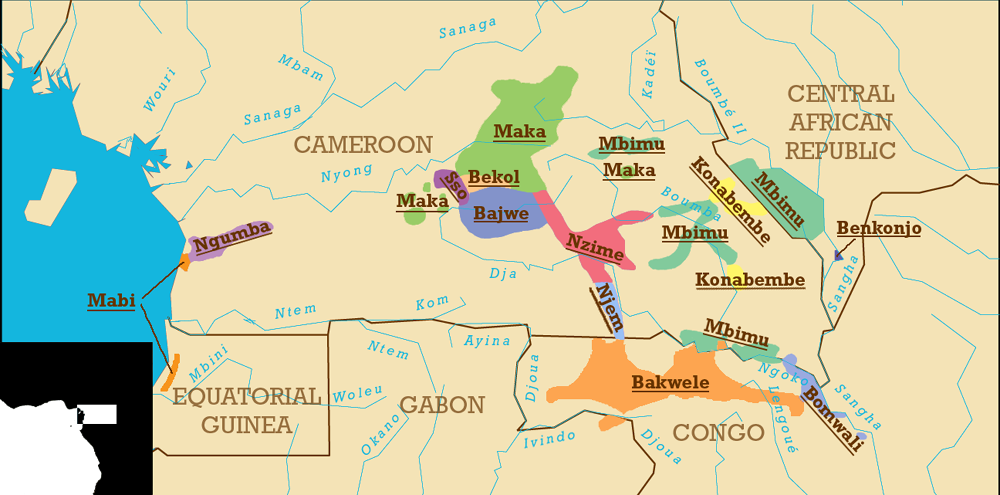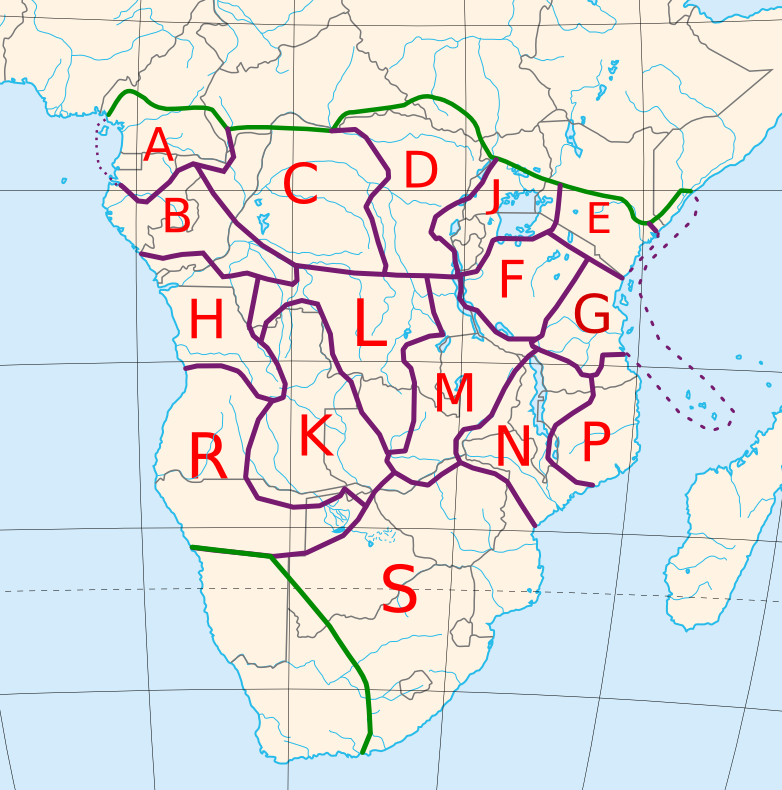|
Koonzime
Nzime (''Koonzime'') is a Bantu language of Cameroon, spoken by the Nzime and Dwe'e (''Bajwe'e'') people. Maho (2009) lists these as two languages. It is closely related to Mpo. Demographics Koonzime is spoken in most of the southern part of the Haut-Nyong region (Eastern Region). The Nzime are located mainly around and east of Lomié, and the closely related Njem The Njyem (or Njem or Ndjem) are an ethnic group inhabiting the rain forest zone of southern Cameroon and northern Republic of the Congo. In Cameroon, the Njyem live along the road running south from Lomié, passing the government center of N ... in Ngoïla commune. Koonzime is spoken by about 30,000 speakers. References Makaa-Njem languages Languages of Cameroon {{Bantu-lang-stub ... [...More Info...] [...Related Items...] OR: [Wikipedia] [Google] [Baidu] |
Makaa–Njem Languages
The Makaa–Njem languages are a group of Bantu languages spoken in Cameroon, the Central African Republic, Equatorial Guinea, Gabon and the Republic of the Congo. They are coded Guthrie classification of Bantu languages#Zone A, Zone A.80 in Guthrie classification of Bantu languages, Guthrie's classification. According to Nurse & Philippson (2003), adding the Kako languages (Guthrie's A.90) forms a valid node, called Pomo–Bomwali (Kairn Klieman 1997). Languages Kako The Guthrie Kako (A.90) languages are: * Kwakum language, Kwakum * Pol language, Pol * Pomo-Kweso language, Pomo-Kweso (Pomo, Kweso) * Kako language, Kako. Makaa–Njem The Guthrie Makaa–Njem (A.80) languages are: Maho (2009) adds Shiwe language, Shiwe (Oshieba) of central Gabon. ''Glottolog'' classifies the languages as follows: * Makaa–Kako (A.80-90) languages: ** Kako language, Kako (or Mkako, Nkoxo, Dikaka, Yaka) ** Kwakum language, Kwakum (or Kpakum, Pakum, Bakum, Abakum, Abakoum, Akpwakum) ** ... [...More Info...] [...Related Items...] OR: [Wikipedia] [Google] [Baidu] |
Nzime
The Nzime are a Bantu ethnic group inhabiting the rain forest zone of southeastern Cameroon. The Nzime live along the road running south of Abong-Mbang, through Mindourou and Lomié, and forking to Zoulabot and Zwadiba. Their territory lies south of the Koonzime in Djaposten, east of the Badwe'e, north of the Njyem, and west of the Konabembe people, all related groups. The Nzime speak the Nzime dialect of Koonzime ("OZM"), one of the Makaa–Njyem Bantu languages. History The Makaa–Njyem-speaking peoples entered present-day Cameroon from the Congo River basin or modern Chad between the 14th and 17th centuries. By the 19th century, they inhabited the lands north of the Lom River in the border region between the present-day East and Adamawa Provinces. Not long thereafter, however, the Beti-Pahuin peoples invaded these areas under pressure from the Vute and Mbum, themselves fleeing Fulani (Fula) warriors. The Makaa–Njyem speakers were forced south. Nzime groups con ... [...More Info...] [...Related Items...] OR: [Wikipedia] [Google] [Baidu] |
Nzime People
The Nzime are a Bantu ethnic group inhabiting the rain forest zone of southeastern Cameroon. The Nzime live along the road running south of Abong-Mbang, through Mindourou and Lomié, and forking to Zoulabot and Zwadiba. Their territory lies south of the Koonzime in Djaposten, east of the Badwe'e, north of the Njyem, and west of the Konabembe people, all related groups. The Nzime speak the Nzime dialect of Koonzime ("OZM"), one of the Makaa–Njyem Bantu languages. History The Makaa–Njyem-speaking peoples entered present-day Cameroon from the Congo River basin or modern Chad between the 14th and 17th centuries. By the 19th century, they inhabited the lands north of the Lom River in the border region between the present-day East and Adamawa Provinces. Not long thereafter, however, the Beti-Pahuin peoples invaded these areas under pressure from the Vute and Mbum, themselves fleeing Fulani (Fula) warriors. The Makaa–Njyem speakers were forced south. Nzime groups continued ... [...More Info...] [...Related Items...] OR: [Wikipedia] [Google] [Baidu] |
Dwe'e People
The Badwe'e (also ''Bajwe'e''; French language, French ''Badjoué'') are an ethnic group inhabiting the rain forest zone of southeastern Cameroon. They recognize themselves as the descendants of Edwe'e, the youngest son of Koo and the brother of Njeme and Nzime. The Badwe'e live south of Messaména in the Eastern Province (Cameroon), East Province in a region south of the Kol people (Cameroon and Gabon), Bekol and both north and west of the Nzime. Their territory includes much of the northern and western border of the Dja Biosphere Reserve. They speak a dialect of Nzime language, Koozime, together with the Nzime people, Nzime. History The ancestors of the Badwe'e lived in the Congo River basin or the present territory of Chad before moving into the present territory of Cameroon between the 14th and 17th centuries. Along with the other speakers of Makaa–Njyem languages, they lived along the northern Lom River near the present-day border between the Adamawa Province, Adamawa and ... [...More Info...] [...Related Items...] OR: [Wikipedia] [Google] [Baidu] |
Guthrie Classification Of Bantu Languages
The 250 or so "Narrow Bantu languages" are conventionally divided up into geographic zones first proposed by Malcolm Guthrie (1967–1971). These were assigned letters A–S and divided into decades (groups A10, A20, etc.); individual languages were assigned unit numbers (A11, A12, etc.), and dialects further subdivided (A11a, A11b, etc.). This coding system has become the standard for identifying Bantu languages; it was a practical way to distinguish many ambiguously named languages before the introduction of ISO 639-3 coding, and it continues to be widely used. Only Guthrie's Zone S is (sometimes) considered to be a genealogical group. Since Guthrie's time a Zone J (made of languages formerly classified in groups D and E) has been set up as another possible genealogical group bordering the Great Lakes. The list is first summarized, with links to articles on accepted groups of Bantu languages (bold decade headings). Following that is the complete 1948 list, as updated by Guthr ... [...More Info...] [...Related Items...] OR: [Wikipedia] [Google] [Baidu] |
Ngoïla
Ngoila, also spelled Ngoyla and Ngoida, is a village in the East Province of Cameroon, located at 2.617° N, 14.017° E. The primary ethnic group is the Njem. Ngoila is the capital of the Ngoila subdivision of the Haut-Nyong division. See also *Communes of Cameroon The Divisions of Cameroon are the third-level units of administration in Cameroon. They are organised by divisions and sub divisions of each province (now Regions). As of 2005 (and since 1996) there are 2 urban communities (Douala and Ya ... References Ngoila at Tageo.com. Accessed 24 May 2006. Populated places in East Region (Cameroon) {{Cameroon-geo-stub ... [...More Info...] [...Related Items...] OR: [Wikipedia] [Google] [Baidu] |
Njem Language
Njem (Njyem) is a Bantu language of Congo and Cameroon. Speakers are mostly (85%) monolingual, and many Baka Baka, baká or BAKA may refer to: Ethnicities and languages * Baka people (Cameroon and Gabon), an African ethnic group * Baka people (Congo and South Sudan), an African ethnic group * Baka language, a dialect cluster of Cameroon and Gabon * Baka ... Pygmies speak Njema as a second language. References Makaa-Njem languages Languages of Cameroon {{Bantu-lang-stub ... [...More Info...] [...Related Items...] OR: [Wikipedia] [Google] [Baidu] |
Lomié
Lomié is a town in the Lomié District in the Upper Nyong division of the East Province of Cameroon. An article in the ''Mail & Guardian Online'' describes it as having "no telephone connection to the outside world, and a single access road that is little more than a forest trail". In fact Lomié has been connected to the cellular phone network since 2006 and the town has had several 'boom' periods. While previous employment came from the logging industry currently the town is near an important cobalt and zinc mining project. The GEOVIC mining company uses Lomié as a base. Lomié has a number of interesting historical buildings, dating from the German and French era. Among these building are the house of the senior civil administrator, a jail, a courthouse and a post-office. The town used to be center of the Upper Nyong Division until it was replaced by Abong-Mbang. Roads from Lomié lead north to Abong-Mbang via Mindourou, east to Messok and Yokadouma and south to Ngoila. ... [...More Info...] [...Related Items...] OR: [Wikipedia] [Google] [Baidu] |
Haut-Nyong
Haut-Nyong is a department of East Province in Cameroon. The department covers an area of 36,384 km and as of 2001 had a total population of 216,768. The capital of the department lies at Abong-Mbang. Subdivisions The department is divided administratively into 14 communes and in turn into villages. Communes * Abong-Mbang * Angossas * Atok * Dimako * Doumaintang * Doumé * Lomié * Mboma * Messamena * Messok * Mindourou * Ngoyla * Nguelemendouka * Somalomo Somalomo is a town and Communes of Cameroon, commune in Cameroon. On October 5, 1992 President Biya of Cameroon signed the decree No. 92/206 officially creating 47 new administrative subdivisions and districts units in the country, consequently ... References Departments of Cameroon East Region (Cameroon) {{Cameroon-geo-stub ... [...More Info...] [...Related Items...] OR: [Wikipedia] [Google] [Baidu] |
Mpo Language
Mpumpong (Mpongmpong) is a Bantu language of Cameroon. Maho (2009) considers Mpiemo to be a dialect. The digraph is pronounced like an English ''p''. Varieties Varieties of Mpo are Mezime, Mpobyáng, Mpopó, Bagéto, Kunabeeb, Mpyámó, Mpomam, Esel, and Bijugi. There is intermediate intercomprehension among these language varieties. Mpo is closely related to Nzime. According to certain Mpobyáng speakers, notably from the villages of Mpak and Zumzazó in the arrondissement of Abong-Mbang, department of Haut-Nyong, Eastern Region, Mpo is the eponymous ancestor of the various Mezime clans: *Byon (commune of Abong-Mbang, Haut-Nyong department, Eastern Region) *Mpopyeet (commune of Mbang, Kadey department) *Mpopó (commune of Yokadouma, department of Boumba-et-Ngoko, Eastern Region) *Kunabeeb (commune of Yokadouma, department of Boumba-et-Ngoko, Eastern Region) *Mpyámo (commune of Yokadouma, department of Boumba-et-Ngoko, Eastern Region) *Mpomam (communes of Lomié and Ngoïla, ... [...More Info...] [...Related Items...] OR: [Wikipedia] [Google] [Baidu] |
Bantu Language
The Bantu languages (English: , Proto-Bantu language, Proto-Bantu: *bantʊ̀), or Ntu languages are a language family of about 600 languages of Central Africa, Central, Southern Africa, Southern, East Africa, Eastern and Southeast Africa, Southeast Africa. They form the largest branch of the Southern Bantoid languages. The total number of Bantu languages is estimated at between 440 and 680 distinct languages, depending on the definition of Dialect#Dialect or language, "language" versus "dialect"."Guthrie (1967–71) names some 440 Bantu 'varieties', Grimes (2000) has 501 (minus a few 'extinct' or 'almost extinct'), Bastin ''et al.'' (1999) have 542, Maho (this volume) has some 660, and Mann ''et al.'' (1987) have ''c.'' 680." Derek Nurse, 2006, "Bantu Languages", in the ''Encyclopedia of Language and Linguistics'', p. 2:Ethnologue report for Southern Bantoid" lists a total of 535 languages. The count includes 13 Mbam languages, which are not always included under "Narrow Bantu". ... [...More Info...] [...Related Items...] OR: [Wikipedia] [Google] [Baidu] |
Cameroon
Cameroon, officially the Republic of Cameroon, is a country in Central Africa. It shares boundaries with Nigeria to the west and north, Chad to the northeast, the Central African Republic to the east, and Equatorial Guinea, Gabon, and the Republic of the Congo to the south. Its coastline lies on the Bight of Biafra, part of the Gulf of Guinea, and the Atlantic Ocean. Due to its strategic position at the crossroads between West Africa and Central Africa, it has been categorized as being in both camps. Cameroon's population of nearly 31 million people speak 250 native languages, in addition to the national tongues of English and French, or both. Early inhabitants of the territory included the Sao civilisation around Lake Chad and the Baka people (Cameroon and Gabon), Baka hunter-gatherers in the southeastern rainforest. Portuguese discoveries, Portuguese explorers reached the coast in the 15th century and named the area ''Rio dos Camarões'' (''Shrimp River''), which became ''C ... [...More Info...] [...Related Items...] OR: [Wikipedia] [Google] [Baidu] |

